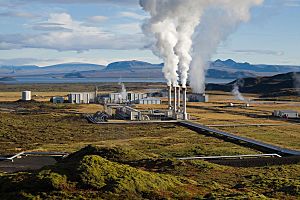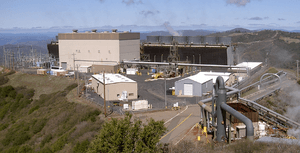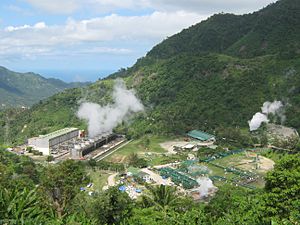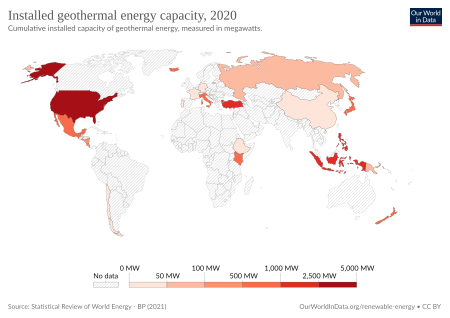Geothermal energy facts for kids


Geothermal energy is power that comes from the heat inside the Earth's crust. The word "geothermal" comes from Greek words: geo means Earth, and thermos means heat.
The Earth's core is super hot. The temperature gets cooler as you move from the core to the surface. This heat comes mostly from radioactive decay of minerals. A smaller part of the heat is left over from when our planet first formed.
We can find geothermal energy in many places. It's in the shallow ground, in hot water and rocks deep underground, and even in molten rock called magma. People have used this energy for bathing for thousands of years. Today, it's also used to make electricity. Geothermal energy often escapes as hot water in hot springs or as steam in geysers.
Contents
How Geothermal Energy is Used
About 10 feet (3 meters) below the Earth's surface, the ground stays at a steady temperature. It's usually between 50° and 60°F (10° and 16°C). This stable temperature is perfect for geothermal heat pumps. These pumps can heat and cool buildings.
A geothermal heat pump system has three main parts. It includes a heat pump, air ducts, and a heat exchanger. The heat exchanger is a system of pipes buried in the ground near a building.
Heating and Cooling Buildings
In winter, the heat pump takes heat from the ground through the pipes. It then moves this heat into the building's air system. In summer, the process is reversed. The heat pump moves heat from inside the building into the cooler ground. This also provides free hot water for the building in summer.
Other Direct Uses
Hot water found close to the Earth's surface can be used directly for heat. This is called "direct-use" geothermal energy. It's used for many things, like heating homes and offices. It also helps grow plants in greenhouses. Farmers use it to dry crops. Fish farms use it to heat water for fish. Some factories even use it for industrial processes, like pasteurizing milk.
In Iceland, many buildings are heated this way. Iceland has many geothermal sites.
Making Electricity
Geothermal energy can also be used to make electricity. This is called geothermal power. Power plants drill wells into underground areas of hot water or steam. Some plants use the steam directly to spin a turbine and generate electricity. Others use the hot water to boil a special liquid. This liquid turns into vapor, which then spins a turbine.
Most geothermal power plants in the United States are in the western states, Alaska, and Hawaii. These areas have many underground hot water reservoirs.
Newer Technologies
Scientists are also exploring ways to use hot dry rocks deep underground. This involves pumping cold water down one well. The water flows through hot, cracked rocks and gets heated. Then, the hot water is brought up another well. This method is not yet used widely.
Another new idea is called enhanced geothermal systems (EGS). These projects are still being developed. They aim to get heat from places where it's harder to reach.
Geothermal power is a renewable energy source. This means we won't run out of it. The amount of heat we take from the Earth is tiny compared to the Earth's total heat. Geothermal power plants also produce very little greenhouse gases. They release much less carbon dioxide than power plants that burn coal.
Environmental Effects
While geothermal energy is clean, there are some things to consider. Fluids from underground can contain gases like carbon dioxide, hydrogen sulfide, methane, and ammonia. If these gases are released, they can cause global warming or acid rain. Modern geothermal plants often have systems to control these emissions.
The water from geothermal sources can also have small amounts of toxic elements. These include mercury, arsenic, and boron. When the water cools, these chemicals can settle and harm the environment. To prevent this, modern practices often return the geothermal fluids back into the Earth. This helps reduce pollution.
Building geothermal plants can sometimes affect the ground. In some places, the ground has sunk. In others, it has risen. Also, enhanced geothermal systems can sometimes cause small earthquakes. This happens when water is injected into rocks deep underground. For example, a project in Basel, Switzerland, was stopped because it caused many small earthquakes.
Compared to other power sources, geothermal plants need less land and water. They use much less land than coal plants or wind farms. They also use a lot less freshwater than nuclear, coal, or oil power plants.
Images for kids
-
The Imperial Valley Geothermal Project near the Salton Sea, California.
See also
 In Spanish: Energía geotérmica para niños
In Spanish: Energía geotérmica para niños





